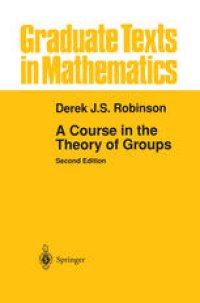
Ebook: A Course in the Theory of Groups
Author: Derek J. S. Robinson (auth.)
- Genre: Mathematics // Symmetry and group
- Tags: Group Theory and Generalizations
- Series: Graduate Texts in Mathematics 80
- Year: 1996
- Publisher: Springer-Verlag New York
- Edition: 2
- Language: English
- pdf
A Course in the Theory of Groups is a comprehensive introduction to the theory of groups - finite and infinite, commutative and non-commutative. Presupposing only a basic knowledge of modern algebra, it introduces the reader to the different branches of group theory and to its principal accomplishments. While stressing the unity of group theory, the book also draws attention to connections with other areas of algebra such as ring theory and homological algebra.
This new edition has been updated at various points, some proofs have been improved, and lastly about thirty additional exercises are included. There are three main additions to the book. In the chapter on group extensions an exposition of Schreier's concrete approach via factor sets is given before the introduction of covering groups. This seems to be desirable on pedagogical grounds. Then S. Thomas's elegant proof of the automorphism tower theorem is included in the section on complete groups. Finally an elementary counterexample to the Burnside problem due to N.D. Gupta has been added in the chapter on finiteness properties.
A Course in the Theory of Groups is a comprehensive introduction to the theory of groups - finite and infinite, commutative and non-commutative. Presupposing only a basic knowledge of modern algebra, it introduces the reader to the different branches of group theory and to its principal accomplishments. While stressing the unity of group theory, the book also draws attention to connections with other areas of algebra such as ring theory and homological algebra.
This new edition has been updated at various points, some proofs have been improved, and lastly about thirty additional exercises are included. There are three main additions to the book. In the chapter on group extensions an exposition of Schreier's concrete approach via factor sets is given before the introduction of covering groups. This seems to be desirable on pedagogical grounds. Then S. Thomas's elegant proof of the automorphism tower theorem is included in the section on complete groups. Finally an elementary counterexample to the Burnside problem due to N.D. Gupta has been added in the chapter on finiteness properties.
A Course in the Theory of Groups is a comprehensive introduction to the theory of groups - finite and infinite, commutative and non-commutative. Presupposing only a basic knowledge of modern algebra, it introduces the reader to the different branches of group theory and to its principal accomplishments. While stressing the unity of group theory, the book also draws attention to connections with other areas of algebra such as ring theory and homological algebra.
This new edition has been updated at various points, some proofs have been improved, and lastly about thirty additional exercises are included. There are three main additions to the book. In the chapter on group extensions an exposition of Schreier's concrete approach via factor sets is given before the introduction of covering groups. This seems to be desirable on pedagogical grounds. Then S. Thomas's elegant proof of the automorphism tower theorem is included in the section on complete groups. Finally an elementary counterexample to the Burnside problem due to N.D. Gupta has been added in the chapter on finiteness properties.
Content:
Front Matter....Pages i-xvii
Fundamental Concepts of Group Theory....Pages 1-43
Free Groups and Presentations....Pages 44-62
Decompositions of a Group....Pages 63-92
Abelian Groups....Pages 93-120
Soluble and Nilpotent Groups....Pages 121-158
Free Groups and Free Products....Pages 159-191
Finite Permutation Groups....Pages 192-212
Representations of Groups....Pages 213-251
Finite Soluble Groups....Pages 252-284
The Transfer and Its Applications....Pages 285-309
The Theory of Group Extensions....Pages 310-355
Generalizations of Nilpotent and Soluble Groups....Pages 356-384
Subnormal Subgroups....Pages 385-415
Finiteness Properties....Pages 416-449
Infinite Soluble Groups....Pages 450-478
Back Matter....Pages 479-502
A Course in the Theory of Groups is a comprehensive introduction to the theory of groups - finite and infinite, commutative and non-commutative. Presupposing only a basic knowledge of modern algebra, it introduces the reader to the different branches of group theory and to its principal accomplishments. While stressing the unity of group theory, the book also draws attention to connections with other areas of algebra such as ring theory and homological algebra.
This new edition has been updated at various points, some proofs have been improved, and lastly about thirty additional exercises are included. There are three main additions to the book. In the chapter on group extensions an exposition of Schreier's concrete approach via factor sets is given before the introduction of covering groups. This seems to be desirable on pedagogical grounds. Then S. Thomas's elegant proof of the automorphism tower theorem is included in the section on complete groups. Finally an elementary counterexample to the Burnside problem due to N.D. Gupta has been added in the chapter on finiteness properties.
Content:
Front Matter....Pages i-xvii
Fundamental Concepts of Group Theory....Pages 1-43
Free Groups and Presentations....Pages 44-62
Decompositions of a Group....Pages 63-92
Abelian Groups....Pages 93-120
Soluble and Nilpotent Groups....Pages 121-158
Free Groups and Free Products....Pages 159-191
Finite Permutation Groups....Pages 192-212
Representations of Groups....Pages 213-251
Finite Soluble Groups....Pages 252-284
The Transfer and Its Applications....Pages 285-309
The Theory of Group Extensions....Pages 310-355
Generalizations of Nilpotent and Soluble Groups....Pages 356-384
Subnormal Subgroups....Pages 385-415
Finiteness Properties....Pages 416-449
Infinite Soluble Groups....Pages 450-478
Back Matter....Pages 479-502
....